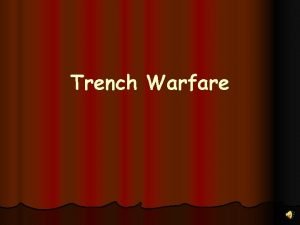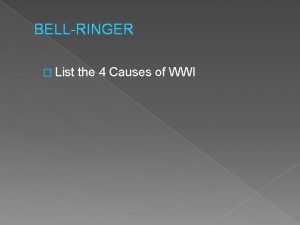Trench Warfare Trenches along the Western Front spread

- Slides: 1

Trench Warfare Trenches along the Western Front spread from the North Sea to the Swiss Frontier from the start of the war. Waterlogged trenches were a constant problem for both armies. The trenches were usually about seven feet deep and six feet wide. Because they were so deep, it was hard to see over the top of the trenches. To be able to see over the top, the armies built a fire step that was 2 feet higher. The frontline trenches were also protected by barbed-wire and machine-gun posts. Barbed-wire was usually placed far enough from the trenches to prevent the enemy from approaching close enough to lob grenades in. Sometimes barbedwire entanglements were set up in order to channel attacking infantry into machine-gun fire. Barbed-wire entanglements were virtually impassable. No Man's Land is the term used by soldiers to describe the ground between the two opposing trenches. The average distance in most sectors was about 250 yards. No Man's Land contained a lot of barbed wire. The areas most likely to be attacked had about ten belts of barbed wire in front of the trenches. In some places the wire was more than a 100 feet thick. If the area had seen a lot of action No Man's Land would be full of broken and abandoned military equipment. After an attack No Man's Land would also contain a large number of bodies. Many men killed in the trenches were buried almost where they fell. If a trench subsided, or new trenches or dugouts were needed, large numbers of decomposing bodies would be found just below the surface. These corpses, as well as the food scraps that littered the trenches, attracted rats. One pair of rats can produce up to 60 offspring in a year and so the trenches were soon swarming with them. Men in the trenches also suffered from lice. Furthermore, The trenches were wet and cold and at this time some of them did not have duckboards or dug-outs. The battalion lived in mud and water. Adapted from: http: //www. spartacus. schoolnet. co. uk

